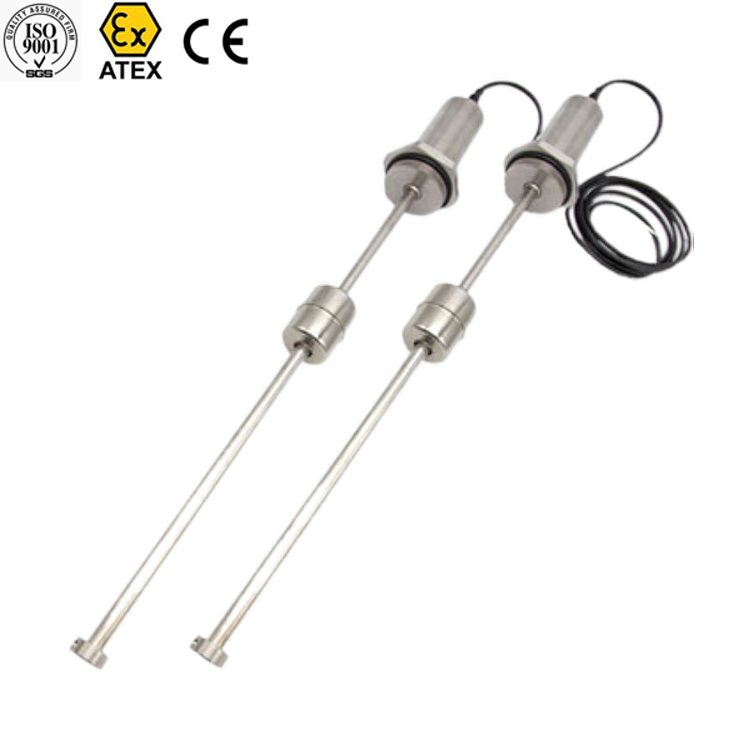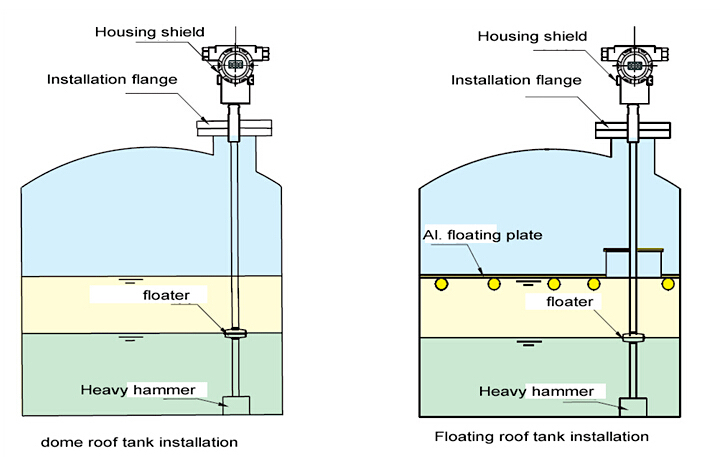Magnetostrictive level sensor is designed with two-wire output interface, and the standard 4-20mA current output mode. Because of its high measurement accuracy, it is widely used in industrial measurement and control of liquid levels in various liquid tanks such as petroleum, biochemical, pharmaceutical, food and beverage, chemical raw material storage, industrial processes, tank farm management and gas station underground storage, and Reservoir water level monitoring, dam water level and sewage treatment, etc.

Before the liquid level gauge is put into use, the water pressure test of 1.5 times the nominal pressure of the liquid level gauge should be carried out for the liquid level gauge for low and medium pressure containers; the liquid level gauge for high pressure containers should be tested for 1.25 times the nominal pressure of the liquid level gauge.
What is the Principle of Magnetostrictive level Sensor?
To comprehend the inner workings of a magnetostrictive level sensor, it is crucial to grasp the underlying principle it operates on. Magnetostriction refers to the phenomenon where certain materials change their shape in response to a magnetic field. In the case of magnetostrictive level sensors, a magnetostrictive wire is used as the sensing element. This wire is composed of two main components: a ferromagnetic core and a non-magnetic, magnetostrictive element. When an electrical current pulse is passed through the wire, a magnetic field is generated, causing the wire to generate a torsional stress wave. This wave propagates along the wire until it reaches the liquid level being measured, where it reflects back to the sensor head. By measuring the time it takes for the wave to travel, the distance to the liquid level can be accurately determined.
Magnetostrictive level sensors offer several distinct advantages over other types of liquid level measurement devices. Firstly, they provide unparalleled accuracy, with resolutions as small as 0.001 inches. This high level of precision makes them ideal for applications that require highly accurate measurements, such as fuel storage tanks or pharmaceutical manufacturing. Additionally, magnetostrictive level sensors offer real-time measurement capabilities, allowing for instantaneous updates on the liquid level. This feature is particularly useful in scenarios where rapid changes in liquid levels need to be closely monitored, such as in chemical processes or wastewater treatment facilities. Furthermore, magnetostrictive level sensors are highly reliable, with long-term stability and minimal drift. This reliability ensures consistent and trustworthy measurements over extended periods, reducing the need for frequent recalibration or maintenance.
How Does a Magnetostrictive Level Sensor Work?
Understanding the inner workings of a magnetostrictive level sensor is vital to fully comprehend its functionality. The sensor consists of two main components: the sensor head and the sensing element. The sensor head contains the electronics responsible for generating and detecting the magnetostrictive wave, while the sensing element is the magnetostrictive wire that interacts with the liquid being measured.
The operation of a magnetostrictive level sensor begins when an electrical current pulse is sent through the magnetostrictive wire. This pulse generates a magnetic field, causing the wire to generate a torsional stress wave that travels along its length. As the wave reaches the liquid level, it reflects back towards the sensor head. The sensor head detects the returning wave and measures the time it takes for the wave to travel, which is known as the “time of flight.” By knowing the speed of the wave, which is constant for a given material, the sensor can accurately calculate the distance to the liquid level.
The sensor head then converts the distance measurement into an analog or digital output signal, depending on the specific model. This signal can be utilized by control systems or displayed on a user interface for convenient monitoring and control. The real-time nature of the measurements provided by magnetostrictive level sensors allows for reliable and accurate monitoring of liquid levels, ensuring optimal efficiency and safety in various industrial applications.
6 safety points magnetostrictive level sensor installation

1.Due to the measurement principle and other factors, when the magnetostrictive level sensor is in a strong magnetic field interference environment, the magnetic field force on the float will be superimposed and demagnetized. Therefore, during installation, it should be kept away from strong electromagnetic environments, such as high-voltage motors, fans, centrifuges, mixers, frequency converters, drying beds, etc., where emergency stop and start are required, these devices should be grounded and shielded. At the same time, the signal line of the magnetostrictive level sensor should be kept away from the high-voltage power line, and the shielding layer of the signal line should be well grounded
2. The liquid level gauge should be installed in a position that is convenient for the operator to investigate, and has lighting explosion-proof devices. If the installation position of the liquid level gauge is not convenient for investigation, other auxiliary equipment should be added; electrostatic discharge will interfere with the measurement of the magnetostrictive level sensor, and the equipment installed with the liquid level gauge should be well grounded during use.
3. After the liquid level gauge device is completed and adjusted, the warning lines of the highest and lowest liquid levels should be drawn on the dial with red paint. A liquid baffle can be set on the upper part of the liquid level gauge that requires a stable liquid level indication;
4. The operating temperature should not exceed the allowed operating temperature of the glass tube and plate. In winter, it is necessary to avoid freezing blockage of the liquid level gauge and the occurrence of false liquid levels; in order to avoid radio frequency electromagnetic field radiation, it is necessary to consider the location of the wireless instrument emission source in the design, and at least ensure a distance of more than 2m.
5. Most of the power frequency magnetic field is generated by the power frequency pump, and the magnetostrictive level sensor should be installed as far away as possible from the power frequency pump.
6. If the temperature of the medium changes too much, the magnetostrictive level sensor should not be used as a metering-grade instrument. However, as long as the average change of 10°C is met, the output value change is less than 2mm, and the error caused by the cumulative change of the medium temperature is generally within the error range of the measurement requirements. When used in a vibrating environment, the accuracy will also be affected. The level gauge is installed in the
under non-vibrating operating conditions.
Installation and Maintenance of Magnetostrictive Level Sensors
Proper installation and regular maintenance are crucial for ensuring optimal performance and longevity of magnetostrictive level sensors. The following factors should be considered during installation:
- Mounting: The sensor head should be securely mounted at a suitable location, ensuring proper alignment with the liquid being measured. Additionally, it is important to ensure sufficient clearance for the sensing element to avoid any obstructions that may interfere with the measurement.
- Calibration: To achieve accurate measurements, the magnetostrictive level sensor must be calibrated according to the specific liquid being measured. This calibration process involves setting the zero point and span of the sensor to match the actual liquid levels.
- Electrical Connections: Proper electrical connections are essential for reliable operation. It is important to follow the manufacturer’s guidelines regarding wiring and grounding to prevent electromagnetic interference and ensure accurate readings.
Regular maintenance of magnetostrictive level sensors is essential to ensure their continued performance. This includes periodic cleaning of the sensing element, inspection of electrical connections, and calibration verification. By following the manufacturer’s recommended maintenance schedule, businesses can maximize the lifespan and accuracy of their magnetostrictive level sensors.
Factors to Consider When Choosing a Magnetostrictive Level Sensor
When selecting a magnetostrictive level sensor for a specific application, several factors should be taken into consideration:
- Measuring Range: Determine the range of liquid levels that need to be measured accurately. Choose a sensor with a suitable measuring range to ensure optimal performance.
- Environment: Consider the environmental conditions in which the sensor will be installed. Factors such as temperature, pressure, and the presence of corrosive substances should be taken into account to select a sensor that is compatible with the operating environment.
- Output Type: Determine whether an analog or digital output is required for seamless integration with existing control systems.
- Accuracy and Resolution: Assess the required level of accuracy and resolution for the application. Consider the desired precision and the smallest liquid level changes that need to be detected.
By carefully considering these factors, you can select a magnetostrictive level sensor that meets their specific requirements, ensuring accurate and reliable liquid level measurements. If you need model selection help, please contact us.
Conclusion
Magnetostrictive level sensors offer a multitude of advantages for industries that rely on precise and real-time liquid level measurements. Their ability to provide high accuracy, real-time measurements, and long-term reliability make them indispensable in a wide range of applications. By understanding the underlying principle and functionality of magnetostrictive level sensors, businesses can make informed decisions when selecting and implementing these sensors. Proper installation, regular maintenance, and considering the relevant factors during the selection process are vital for maximizing the performance and longevity of magnetostrictive level sensors. With their exceptional capabilities, magnetostrictive level sensors continue to play a crucial role in ensuring efficient and safe operations across various industries.




